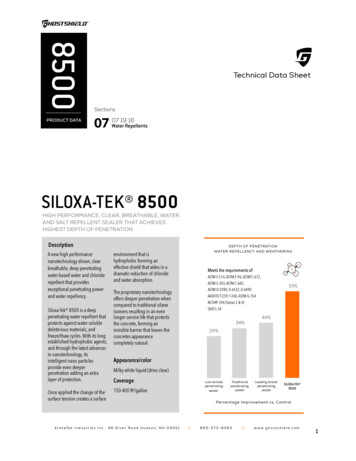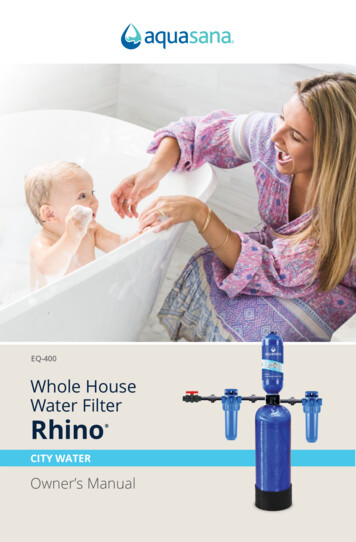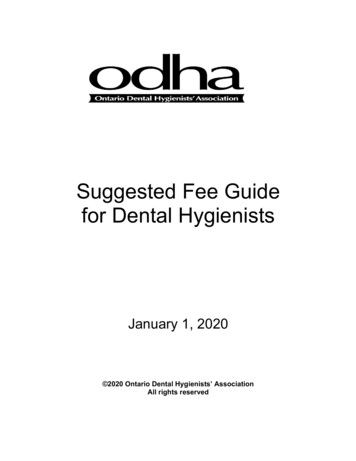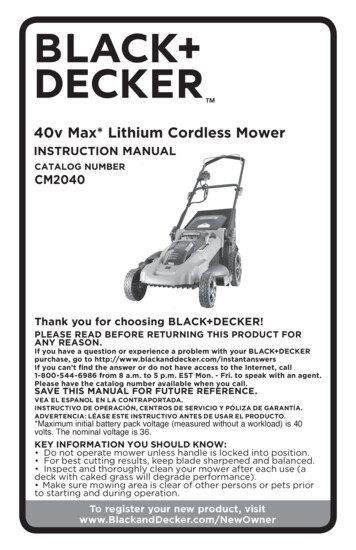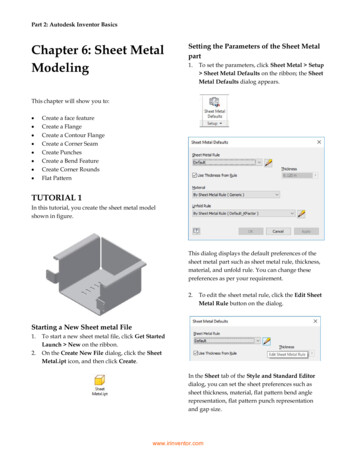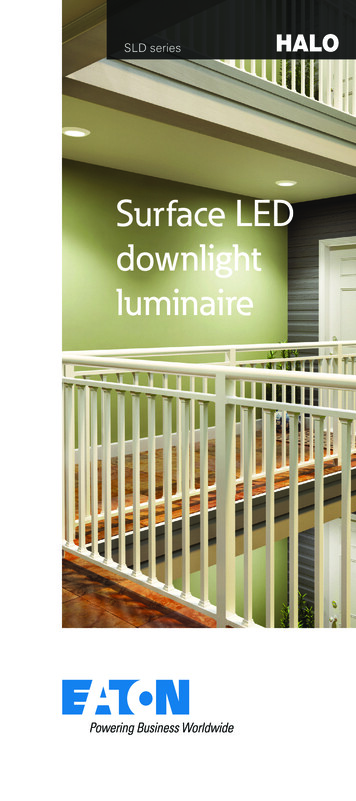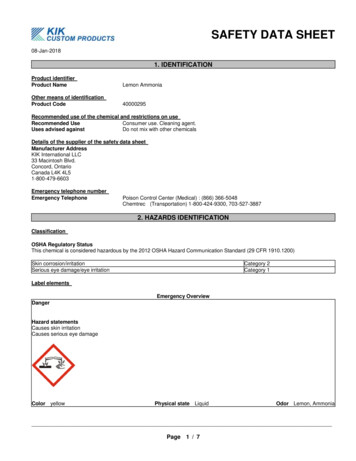
Transcription
SAFETY DATA SHEET08-Jan-20181. IDENTIFICATIONProduct identifierProduct NameLemon AmmoniaOther means of identificationProduct Code40000295Recommended use of the chemical and restrictions on useRecommended UseConsumer use. Cleaning agent.Uses advised againstDo not mix with other chemicalsDetails of the supplier of the safety data sheetManufacturer AddressKIK International LLC33 Macintosh Blvd.Concord, OntarioCanada L4K 4L51-800-479-6603Emergency telephone numberEmergency TelephonePoison Control Center (Medical) : (866) 366-5048Chemtrec (Transportation) 1-800-424-9300, 703-527-38872. HAZARDS IDENTIFICATIONClassificationOSHA Regulatory StatusThis chemical is considered hazardous by the 2012 OSHA Hazard Communication Standard (29 CFR 1910.1200)Skin corrosion/irritationSerious eye damage/eye irritationCategory 2Category 1Label elementsEmergency OverviewDangerHazard statementsCauses skin irritationCauses serious eye damageColor yellowPhysical state LiquidOdor Lemon, AmmoniaPage 1 / 7
Lemon AmmoniaRevision Date 08-Jan-2018Precautionary Statements - PreventionWash face, hands and any exposed skin thoroughly after handlingWear protective gloves/protective clothing/eye protection/face protectionPrecautionary Statements - ResponseImmediately call a POISON CENTER or doctor/physicianIF IN EYES: Rinse cautiously with water for several minutes. Remove contact lenses, if present and easy to do. Continue rinsingImmediately call a POISON CENTER or doctor/physicianIF ON SKIN: Wash with plenty of soap and waterIf skin irritation occurs: Get medical advice/attentionTake off contaminated clothing and wash before reuseHazards not otherwise classified (HNOC)Not applicableOther Information0.09899% of the mixture consists of ingredient(s) of unknown toxicity3. COMPOSITION/INFORMATION ON INGREDIENTSMixtureChemical NameAmmonium hydroxideCAS No.1336-21-6Weight-%1-44. FIRST AID MEASURESDescription of first aid measuresEye contactRinse thoroughly with plenty of water for at least 15 minutes, lifting lower and upper eyelids.Consult a physician.Skin contactWash skin with soap and water. If symptoms persist, call a physician.InhalationRemove to fresh air.IngestionDo NOT induce vomiting. Clean mouth with water and drink afterwards plenty of water. Ifsymptoms persist, call a physician.Self-protection of the first aiderUse personal protective equipment as required.Most important symptoms and effects, both acute and delayedSymptomsNo information available.Indication of any immediate medical attention and special treatment neededNote to physiciansTreat symptomatically.5. FIRE-FIGHTING MEASURESSuitable extinguishing mediaUse extinguishing measures that are appropriate to local circumstances and the surrounding environment.Unsuitable extinguishing mediaNo information available.Page 2 / 7
Lemon AmmoniaRevision Date 08-Jan-2018Specific hazards arising from the chemicalNo information available.Explosion dataSensitivity to Mechanical Impact None.Sensitivity to Static Discharge None.Protective equipment and precautions for firefightersAs in any fire, wear self-contained breathing apparatus pressure-demand, MSHA/NIOSH (approved or equivalent) and fullprotective gear.6. ACCIDENTAL RELEASE MEASURESPersonal precautions, protective equipment and emergency proceduresPersonal precautionsAvoid contact with skin, eyes or clothing. Use personal protective equipment as required.Ensure adequate ventilation, especially in confined areas.Environmental precautionsEnvironmental precautionsSee Section 12 for additional ecological information.Methods and material for containment and cleaning upMethods for containmentPrevent further leakage or spillage if safe to do so.Methods for cleaning upPick up and transfer to properly labeled containers.7. HANDLING AND STORAGEPrecautions for safe handlingAdvice on safe handlingAvoid contact with skin, eyes or clothing. Handle in accordance with good industrial hygieneand safety practice.Conditions for safe storage, including any incompatibilitiesStorage ConditionsKeep containers tightly closed in a dry, cool and well-ventilated place.Incompatible materialsChlorine-based bleaching agents.8. EXPOSURE CONTROLS/PERSONAL PROTECTIONControl parametersExposure GuidelinesThis product, as supplied, does not contain any hazardous materials with occupationalexposure limits established by the region specific regulatory bodies.Appropriate engineering controlsEngineering ControlsShowersEyewash stationsVentilation systems.Individual protection measures, such as personal protective equipmentEye/face protectionWear safety glasses with side shields (or goggles).Page 3 / 7
Lemon AmmoniaRevision Date 08-Jan-2018Skin and body protectionWear protective gloves and protective clothing.Respiratory protectionIf exposure limits are exceeded or irritation is experienced, NIOSH/MSHA approvedrespiratory protection should be worn. Positive-pressure supplied air respirators may berequired for high airborne contaminant concentrations. Respiratory protection must beprovided in accordance with current local regulations.General Hygiene ConsiderationsHandle in accordance with good industrial hygiene and safety practice.9. PHYSICAL AND CHEMICAL PROPERTIESInformation on basic physical and chemical propertiesPhysical stateAppearanceColorLiquidaqueous solutionyellowPropertypHMelting point / freezing pointBoiling point / boiling rangeFlash pointEvaporation rateFlammability (solid, gas)Flammability Limit in AirUpper flammability limit:Lower flammability limit:Vapor pressureVapor densitySpecific GravityWater solubilitySolubility in other solventsPartition coefficientAutoignition temperatureDecomposition temperatureKinematic viscosityDynamic viscosityDensityBulk densityExplosive propertiesOxidizing propertiesValues11.0-12.0No information available100 C / 212 C FNo information availableNo information availableNo information availableOdorOdor thresholdLemon, AmmoniaNo information availableRemarks MethodNo information availableNo information availableNo information availableNo information available0.99 - 1.00Soluble in waterNo information availableNo information availableNo information availableNo information availableNo information availableNo information availableNo information availableNo information availableNo information availableNo information availableOther InformationSoftening pointMolecular weightVOC Content (%)No information availableNo information availableNo information available10. STABILITY AND REACTIVITYReactivityNo data availableChemical stabilityStable under recommended storage conditions.Possibility of Hazardous ReactionsNone under normal processing.Conditions to avoidDo not mix with other chemicals. Extremes of temperature and direct sunlight.Page 4 / 7
Lemon AmmoniaRevision Date 08-Jan-2018Incompatible materialsChlorine-based bleaching agents.Hazardous Decomposition ProductsNone known based on information supplied.11. TOXICOLOGICAL INFORMATIONInformation on likely routes of exposureProduct InformationInhalationAvoid breathing vapors or mists.Eye contactAvoid contact with eyes. May cause burns.Skin contactAvoid contact with skin. Contact causes severe skin irritation and possible burns.IngestionMay be harmful if swallowed.Component InformationChemical NameAmmonium hydroxide1336-21-6Oral LD50 350 mg/kg ( Rat )Dermal LD50-Inhalation LC50-Information on toxicological effectsSymptomsNo information available.Delayed and immediate effects as well as chronic effects from short and long-term exposureSensitizationGerm cell mutagenicityCarcinogenicityNo information available.No information available.The table below indicates whether each agency has listed any ingredient as a carcinogen.Reproductive toxicitySTOT - single exposureSTOT - repeated exposureTarget Organ EffectsAspiration hazardNo information available.No information available.No information available.Eyes, Respiratory system, Skin.No information available.Numerical measures of toxicity - Product InformationThe following values are calculated based on chapter 3.1 of the GHS documentATEmix (inhalation-gas)95238 mg/lATEmix (inhalation-dust/mist) 23.9 mg/l12. ECOLOGICAL INFORMATIONEcotoxicityHarmful to aquatic life with long lasting effects0.09899% of the mixture consists of components(s) of unknown hazards to the aquatic environmentChemical NameAmmonium hydroxide1336-21-6Algae/aquatic plants-Fish8.2: 96 h Pimephales promelasmg/L LC50Crustacea0.66: 48 h water flea mg/L EC500.66: 48 h Daphnia pulex mg/LEC50Page 5 / 7
Lemon AmmoniaRevision Date 08-Jan-2018Persistence and degradabilityNo information available.BioaccumulationNo information available.MobilityNo information available.Other adverse effectsNo information available13. DISPOSAL CONSIDERATIONSWaste treatment methodsDisposal of wastesDisposal should be in accordance with applicable regional, national and local laws andregulations.Contaminated packagingDo not reuse container. Dispose of in accordance with federal, state and local regulations.14. TRANSPORT INFORMATIONDOTNot regulatedIATANot regulatedIMDGNot regulated15. REGULATORY INFORMATIONInternational InventoriesTSCADSL/NDSLCompliesCompliesLegend:TSCA - United States Toxic Substances Control Act Section 8(b) InventoryDSL/NDSL - Canadian Domestic Substances List/Non-Domestic Substances ListUS Federal RegulationsSARA 313Section 313 of Title III of the Superfund Amendments and Reauthorization Act of 1986 (SARA). This product does not contain anychemicals which are subject to the reporting requirements of the Act and Title 40 of the Code of Federal Regulations, Part 372SARA 311/312 Hazard CategoriesAcute health hazardChronic Health HazardFire hazardSudden release of pressure hazardReactive HazardYesNoNoNoNoPage 6 / 7
Lemon AmmoniaRevision Date 08-Jan-2018CWA (Clean Water Act)This product contains the following substances which are regulated pollutants pursuant to the Clean Water Act (40 CFR 122.21and 40 CFR 122.42)Chemical NameAmmonium hydroxide1336-21-6CWA - ReportableQuantities1000 lbCWA - Toxic PollutantsCWA - Priority Pollutants--CWA - HazardousSubstancesXCERCLAThis material, as supplied, contains one or more substances regulated as a hazardous substance under the ComprehensiveEnvironmental Response Compensation and Liability Act (CERCLA) (40 CFR 302)Chemical NameAmmonium hydroxide1336-21-6Hazardous Substances RQs1000 lbCERCLA/SARA RQ-Reportable Quantity (RQ)RQ 1000 lb final RQRQ 454 kg final RQMassachusettsXPennsylvaniaXUS State RegulationsCalifornia Proposition 65This product does not contain any Proposition 65 chemicalsU.S. State Right-to-Know RegulationsChemical NameAmmonium hydroxide1336-21-6New JerseyXU.S. EPA Label InformationEPA Pesticide Registration Number This product does not contain any substances regulated as pesticidesDifference between SDS and CPSC labelThis product is regulated under Consumer Product Safety Commission and is subject to certain labeling requirements under theFederal Hazardous Substances Act (16 CFR Part 1500) . These requirements differ from the classification criteria and hazardinformation required for safety data sheets and for workplace product labels.16. OTHER INFORMATION, INCLUDING DATE OF PREPARATION OF THE LAST REVISIONNFPAHealth hazards 2Flammability 0Instability 0HMISHealth hazards 2Flammability 0Physical hazards 0Physical and ChemicalProperties Personal protection BPrepared ByRegulatory AffairsRevision Date08-Jan-2018Revision NoteNo information availableDisclaimerThe information provided in this Material Safety Data Sheet is correct to the best of our knowledge, information and beliefat the date of its publication. The information given is designed only as a guidance for safe handling, use, processing,storage, transportation, disposal and release and is not to be considered a warranty or quality specification. Theinformation relates only to the specific material designated and may not be valid for such material used in combinationwith any other materials or in any process, unless specified in the text.End of Safety Data SheetPage 7 / 7
Odor Lemon, Ammonia . . Disposal of wastes Disposal should be in accordance with applicable regional, national and local laws and regulations. Contaminated packaging Do not reuse container. Dispose of in accordance with federal, state and local regulations. . Chemical Name New Jersey Massachusetts Pennsylvania Ammonium hydroxide 1336-21-6 X .
